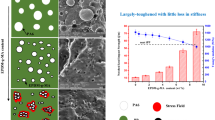Abstract
Hydrophobic-associated polymer is widely used as thickener in the presence of Ca2+ or Na+. Three polymers including partially hydrolyzed polyacrylamide (HPAM) and hydrophobically associating polymers (CHAP and CBHAP) were used to clarify the thickening mechanism. The fractal aggregation process, microstructure and the interaction between polymers and metal ions were investigated by using laser light scattering, scanning electron microscope and ion meter. The experimental results show that dehydration and electrostatic shielding cause the reduction of viscosity in the presence of Ca2+ and Na+. The amounts of flocculates and the high chelating concentration demonstrate the strong interaction between polymer chains and metal ions. By improving the hydrophobicity of both polymer main chains and side chains, the interaction is weakened, as a result, complete and independent special network and low chelating concentration of CBHAP are found, respectively. The results may provide a good strategy for the design of salt-resistant polymers.









Similar content being viewed by others
References
Druetta P, Picchioni F (2019) Influence of the polymer degradation on enhanced oil recovery processes. Appl Math Model 69:142–163
Wu G, Yu L, Jiang X (2018) Synthesis and properties of an acrylamide-based polymer for enhanced oil recovery: A preliminary study. Adv Polym Technol 37(8):2763–2773
Elhaei R, Kharrat R, Madani M (2021) Stability, flocculation, and rheological behavior of silica suspension-augmented polyacrylamide and the possibility to improve polymer flooding functionality. J Mol Liquids 322:114572
Hashmet MR, Onur M, Tan IM (2014) Empirical correlations for viscosity of polyacrylamide solutions with the effects of salinity and hardness. J Dispersion Sci Technol 35(4):510–517
Fakher S, Ahdaya M, Imqam A (2020) Hydrolyzed polyacrylamide—fly ash reinforced polymer for chemical enhanced oil recovery: part 1—injectivity experiments. Fuel 260:116310–116319
Choi BI, Jeong MS, Lee KS (2014) Temperature-dependent viscosity model of HPAM polymer through high-temperature reservoirs. Polym Degrad Stab 110:225–231
Kujawa P, Audiberthayet A, Selb J et al (2006) Effect of Ionic strength on the rheological properties of multisticker associative polyelectrolytes. Macromolecules 39(1):384–392
Løbø Viken A, Skauge T, Spildo K (2016) Rheological properties of a hydrophobically modified anionic polymer: effect of varying salinity and amount of hydrophobic moieties. J Appl Polym Sci 133(23):43520–43528
Rivas BL, Pereira ED, Moreno-Villoslada I (2008) Water-soluble polymer-metal ion interactions. Prog Polym Sci 28(2):173–208
Peng S, Wu C (1999) Light scattering study of the formation and structure of partially hydrolyzed poly (acrylamide)/calcium (II) complexes. Macromolecules 32(3):585–589
Guetni I, Marlière C, Rousseau D et al (2020) Transport of EOR polymer solutions in low permeability porous media: Impact of clay type and injection water composition. J Petrol Sci Eng 186:106690–106704
Samanta A, Bera A, Ojha K et al (2010) Effects of alkali, salts, and surfactant on rheological behavior of partially hydrolyzed polyacrylamide solutions†. J Chem Eng Data 55(10):4315–4322
Yuan R, Li Y, Li C et al (2013) Study about how the metal cationic ions affect the properties of partially hydrolyzed hydrophobically modified polyacrylamide (HMHPAM) in aqueous solution. Colloids Surf A Physicochem Eng Aspects 434:16–24
Ma Q, Shuler PJ, Aften CW et al (2015) Theoretical studies of hydrolysis and stability of polyacrylamide polymers. Polym Degrad Stab 121:69–77
Muthukumar M (2020) Trends in polymer physics and theory. Prog Polym Sci 100:101184–101191
Kwon H-K, Ma B, Olvera de la Cruz M (2019) Determining the regimes of dielectric mismatch and ionic correlation effects in ionomer blends. Macromolecules 52(2):535–546
Podgornik R (2018) General theory of charge regulation and surface differential capacitance. J Chem Phys 149(10):104701–104708
Pu W, Jiang F, He Y et al (2016) Synthesis of a novel comb micro-block hydrophobically associating copolymer for Ca2+/Mg2+ resistance. RSC Adv 6(49):43634–43637
Huang J, Zhong C, Wu X (2017) Shear behavior at high pressures and viscoelastic properties in water and in brine solutions with high salinities for a tetra-polymer containing poly(ethylene oxide) side chains. RSC Adv 7(75):47624–47635
Viken AL, Skauge T, Svendsen PE et al (2018) Thermothickening and salinity tolerant hydrophobically modified polyacrylamides (HMPAMs) for polymer flooding. Energy Fuels 32(10):10421–10427
Jiang F, Pu W (2020) Salt induced shear thickening behavior of a hydrophobic association polymer and its potential in enhanced oil recovery. J Mater Sci 55(7):3130–3138
Grillo I, Morfin I, Combet J (2020) Chain conformation: a key parameter driving clustering or dispersion in polyelectrolyte—colloid systems. J Colloid Interface Sci 561:426–438
Afolabi RO, Oluyemi GF, Officer S et al (2019) Hydrophobically associating polymers for enhanced oil recovery—part A: a review on the effects of some key reservoir conditions. J Petrol Sci Eng 180:681–698
Du D, Pu W, Hu P et al (2020) p-Sulfocalix arene functionalized hydrophobically associative polyacrylamide: flow characteristics and potential application to enhanced oil recovery. Polym Eng Sci 60(6):1291–1300
Hill A, Candau F, Selb J (1993) Properties of hydrophobically associating polyacrylamides: influence of the method of synthesis. Macromolecules 26(17):4521–4532
Pu W, Jiang F, Wei B et al (2017) Influences of structure and multi-intermolecular forces on rheological and oil displacement properties of polymer solutions in the presence of Ca2+/Mg2+. RSC Adv 7(8):4430–4436
Ball RC, Weitz DA, Witten TA et al (1987) Universal Kinetics in Reaction-Limited Aggregation. Phys Rev Lett 58(3):274–277
Acknowledgements
The research is supported by Open Fund (LYJ1904) of Sichuan Provincial University Key Laboratory of Green Catalysis, Innovation and Entrepreneurship Project (S202010638078) of China West Normal University.
Author information
Authors and Affiliations
Corresponding author
Additional information
Publisher's Note
Springer Nature remains neutral with regard to jurisdictional claims in published maps and institutional affiliations.
Supplementary Information
Below is the link to the electronic supplementary material.
Rights and permissions
About this article
Cite this article
Jiang, F., Wang, H., Ye, Z. et al. Thickening mechanism of water-soluble polymer in the presence of Ca2+ and Na+. Polym. Bull. 79, 7909–7921 (2022). https://doi.org/10.1007/s00289-021-03886-5
Received:
Revised:
Accepted:
Published:
Issue Date:
DOI: https://doi.org/10.1007/s00289-021-03886-5




